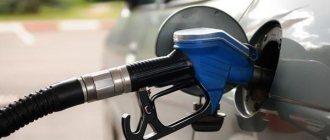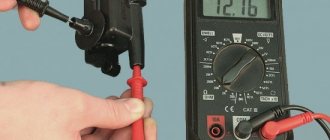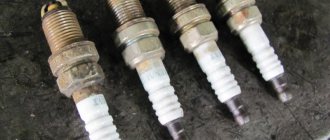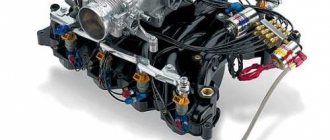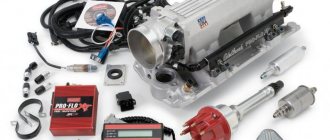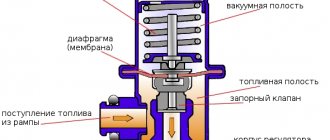The effect of spark plugs on fuel consumption: what the driver needs to know
Hello everyone, friends! We are still considering all the existing nuances regarding vehicle fuel consumption and its reduction. Few people, however, know that there is an effect of spark plugs on fuel consumption, and this is the absolute truth. In other words, the better condition they are, the more economical the engine will be. Now let's talk about this in more detail.
The relationship between spark plugs and fuel consumption
Almost every car owner has to find out the reasons for increased consumption over time. It is believed that there is an influence of spark plug gap on the amount of fuel that will be consumed by a vehicle with an internal combustion engine. An incorrectly set gap is nothing more than the minimum distance between the side and central electrodes. It is this that can lead to interruptions in the operation of the spark plug, as well as to an increase in fuel consumption.
What happens in an engine when it is running with one or two faulty spark plugs? As a rule, it starts up worse and works with noticeable interruptions. In addition, this immediately affects the ignition of the mixture in the cylinders, and not completely burned fuel simply flies out into the exhaust system, thereby disabling the catalytic converter. It goes without saying that all this time we have been observing increased fuel consumption.
How does spark plug gap affect gas mileage? It’s very simple - the formation of a spark is directly related to the size of the electrodes and the distance (gap) between them. The electrodes are made quite thick, from a special refractory metal, which extends the service life of such a product. Bad spark plugs are often plugs with incorrectly set gaps. They should be as recommended by the manufacturer.
What types of spark plugs are there and their external faults?
What happens if you deviate from such recommendations? Either increasing or decreasing the distance between the electrodes does not bring anything good. This leads to a decrease in the intensity of spark formation, and at the same time to an increase in gaps during the ignition process. However, during operation, the electrode gradually burns out, and thus the gap grows.
Typically, spark plugs can last up to 30 thousand kilometers. Each manufacturer strives to increase their resource. Does this fact affect the conditions of economical operation and, first of all, fuel consumption indicators? Of course, yes, we described this in more detail above. Spark plugs are already being produced that can travel up to 100 thousand kilometers. They cost significantly more, but their service life depends on operating conditions. These products are quite fragile in themselves, and low-grade oil or gasoline of dubious quality lead to a decrease in their service life.
Even among car enthusiasts there is such a thing as “dry spark plugs”. On the one hand, it’s good when they are not filled with gasoline, but on the other hand, this may indicate the following problems related to the fuel supply:
- the fuel pump motor has failed;
- pipelines are frozen or clogged;
- the coarse fuel filter is clogged;
- There is a problem with the injectors.
The appearance of soot and dark plaque
A much more common malfunction is black spark plugs, which is associated with darkening of the ceramic coating by combustion and fuel processing products. This can be caused by any change in the operation of the power unit, a faulty injector or low-quality fuel. Quite often, only one spark plug from the entire row darkens, and the reason for this may be in it itself, and not necessarily in the operation of the elements of the piston group. This may be due to the wire or tip not working.
The deposit may be applied unevenly, which indicates that the spark plug does not match the specific markings of the car engine. For example, if the heat value is higher than the permissible value, then the top of the candle will turn black, while its body will retain a snow-white hue. Their darkening can also be affected by ignition that is too late. In the case of a faulty injector, a similar effect also occurs, which is associated with the working mixture being too rich. Thus, if after replacing the spark plugs your fuel consumption increases, check how well they match the engine of your car.
As you can see, any problem can and should be diagnosed. The sooner this is done, the sooner it will be possible to understand why the car began to “eat” more gasoline or diesel fuel, and whether the spark plugs are to blame. See you in new publications and articles! Have a good day!
Sincerely, blog author Andrey Kulpanov
'; blockSettingArray[0]["setting_type"] = 3; blockSettingArray[0]["element"] = ""; blockSettingArray[0]["directElement"] = ".info-bar"; blockSettingArray[0][“elementPosition”] = 1; blockSettingArray[0][“elementPlace”] = 2; blockSettingArray[1] = []; blockSettingArray[1]["minSymbols"] = 0; blockSettingArray[1]["minHeaders"] = 0; blockSettingArray[1][“text”] = '
'; blockSettingArray[1]["setting_type"] = 6; blockSettingArray[1][“elementPlace”] = 30; blockSettingArray[2] = []; blockSettingArray[2]["minSymbols"] = 0; blockSettingArray[2]["minHeaders"] = 0; blockSettingArray[2][“text”] = '
'; blockSettingArray[2][“setting_type”] = 6; blockSettingArray[2]["elementPlace"] = 70; blockSettingArray[3] = []; blockSettingArray[3]["minSymbols"] = 0; blockSettingArray[3]["minHeaders"] = 0; blockSettingArray[3][“text”] = '
'; blockSettingArray[3]["setting_type"] = 3; blockSettingArray[3]["element"] = ""; blockSettingArray[3]["directElement"] = ".look-like"; blockSettingArray[3][“elementPosition”] = 0; blockSettingArray[3][“elementPlace”] = 2; blockSettingArray[4] = []; blockSettingArray[4]["minSymbols"] = 0; blockSettingArray[4]["minHeaders"] = 0; blockSettingArray[4][“text”] = '
'; blockSettingArray[4]["setting_type"] = 3; blockSettingArray[4]["element"] = ""; blockSettingArray[4]["directElement"] = "#categories-3"; blockSettingArray[4][“elementPosition”] = 0; blockSettingArray[4][“elementPlace”] = 2; blockSettingArray[5] = []; blockSettingArray[5]["minSymbols"] = 0; blockSettingArray[5]["minHeaders"] = 0; blockSettingArray[5][“text”] = '
'; blockSettingArray[5]["setting_type"] = 3; blockSettingArray[5]["element"] = "p"; blockSettingArray[5]["directElement"] = "#categories-3"; blockSettingArray[5][“elementPosition”] = 1; blockSettingArray[5][“elementPlace”] = 2; blockSettingArray[6] = []; blockSettingArray[6]["minSymbols"] = 0; blockSettingArray[6]["minHeaders"] = 0; blockSettingArray[6][“text”] = '
'; blockSettingArray[6]["setting_type"] = 3; blockSettingArray[6]["element"] = "p"; blockSettingArray[6]["directElement"] = "#mc4wp_form_widget-3"; blockSettingArray[6][“elementPosition”] = 1; blockSettingArray[6][“elementPlace”] = 2; var jsInputerLaunch = 15;
Place for contest advertising
Author:Andrey
avto-kul.ru
Features of the functioning of the ignition system
One basic physical principle has been introduced into the ignition system, which allows us to understand how spark plugs affect fuel consumption. Let us recall that in the process of operation of the entire system, electrical energy is converted into that very movable energy - thermal. This process starts due to the resulting discharge between the electrodes in the spark plugs.
According to technical documents, it is known that for normal operation of the engine and combustion of the working mixture in the cylinders, an electrical discharge voltage of at least 10 kV is required. And with an increase in this number, the gap between the sparks of the electrodes increases. It cannot be said that this has a positive effect on the ignition system; all devices and components are under load, and the car owner calculates the cost of gasoline, increasing the number of refills. Here is the first answer to how spark plugs affect gasoline consumption and why there are malfunctions in the system.
It is believed that not only the power of the electric charge, but also the time intervals between ignition of the working mixture are of great importance. They practically affect the operation of the engine, its starting and maneuvering features. The optimal operating option is manifested in the interaction of several components and even technical parameters are indicated.
After Replacing Spark Plugs Fuel Consumption Increased ~ VESKO-TRANS.RU
Reasons for huge fuel consumption on Lada Kalina , what to do?
Naturally, increased fuel consumption on the Lada Kalina is a nasty phenomenon for the owner of the car. This hits the pocket significantly. But not every car owner is able to find why consumption . And not everyone knows how to fix this problem!
The main reasons for high fuel consumption on the Lada Kalina
There are quite a lot of circumstances, but in this article we will try to look at everything.
At first, this is due to incorrect operation of the car and untimely maintenance. So, what are the prerequisites for the huge fuel consumption of the Lada Kalina :
It's time to change this air filter
Condition of the candles in the photo
The photo shows a not very dirty BDZ, it can be worse
Do spark plugs affect fuel consumption?
Good afternoon, dear friends, although for some it may well be evening! I hasten to continue the series of publications, which is devoted to the fuel consumption of a modern internal combustion engine. Surely, each of you has heard at least once about how spark plugs affect fuel consumption. I have no doubt that this topic will be of interest to a wide range of car enthusiasts. Therefore, let’s dwell on it in more detail.
How to determine the need for replacement
Let's start with the fact that many drivers are faced with a dilemma: whether to change the spark plugs only after actual wear, or to do it after a certain mileage, as recommended by manufacturers, even if the spark plugs are normal in appearance. An unscheduled replacement, of course, is a more correct solution, but let’s consider the situation of what happens if the replacement does not take place on time.
Many different criteria influence how long new (white) spark plugs can last. In many ways, this is influenced by the driving style of the car, their quality and manufacturer, the general condition in which the car’s engine is located, the quality and grade of fuel, etc. If the products are new, they can keep the engine running in optimal and efficient condition. At the same time, they themselves serve to create a spark with a discharge of tens of thousands of volts, which could ignite the air-fuel mixture in the cylinders in the shortest possible time.
What are the dangers of used spark plugs?
Any problems during the ignition process immediately affect the remaining unburnt fuel, as well as the engine’s power performance. At the same time, replacing black candles or those that have long expired is not at all difficult. Even a beginner can handle this with a special key.
Thanks to the Check Engine indicator, which is equipped on the dashboard of modern cars, the driver can promptly detect that there are certain problems with the engine. If the spark plugs are too worn out, misfires begin to occur, which reduce engine performance. Therefore, certain mileage standards are provided.
Thus, conventional spark plugs should be changed every 30–50 thousand kilometers traveled, depending on their manufacturer. There are higher quality products - they are designed for a mileage of up to 90 and even 100 thousand km. And this indicator may change, since it is influenced even by the quality of the fuel poured into the tank and the condition of the power unit itself.
Excessive fuel consumption and faulty spark plugs
To understand the effect of a spark plug on excessive fuel consumption, you should look a little more closely at its design. It consists of an insulator with ribs, a contact terminal, electrodes and an O-ring. Everyone has heard that there is such a thing as spark plug gap. In practice, this is precisely the distance that exists between the side and central electrodes. It is between the two of them that the spark occurs, which is required to ignite the working mixture.
Now let’s try to identify the symptoms indicating a malfunction in the spark plugs:
- the engine operates unstably, including at idle, power drops, in other words, it “troubles”;
- it becomes difficult to start the engine, or this happens after prolonged rotation with the starter;
- fuel consumption and the content of harmful elements in exhaust gases increases;
- The previous dynamics of the engine are lost.
Spark plugs made of iridium and platinum - the better
Traditional electrode spark plugs have long been the only alternative in internal combustion engines. However, recently other products have appeared on the market that have improved characteristics. Take, for example, platinum candles - more expensive, but strong, equipped with several electrodes, which can be located in the center or on the sides.
The name itself suggests that they use precious metal from which a special surfacing is made. Or platinum is used to create an electrode - and as a result it becomes less susceptible to chemical damage or corrosion than the usual alloy of chromium and nickel.
Another interesting and popular solution could be iridium spark plugs. They have such a thin electrode that its thickness does not exceed 0.4 mm. Thanks to this, less carbon deposits accumulate and the service life increases. In addition to extended mileage, manufacturers promise savings in fuel consumption and ease of starting the engine.
It is necessary to choose the right spark plug based on the recommendations of the car manufacturer. They are contained in the instructions for the vehicle. Be sure to take into account such a criterion as the “heat number”, which should be as close as possible to the original spark plugs. In addition, the thermal characteristics of this product are assessed, which directly affect both engine power and fuel consumption.
This brings our discussion today to its logical conclusion. However, many useful articles and materials await us ahead. Stay with us to receive new information regularly. In the meantime - see you again!
Sincerely, blog author Andrey Kulpanov
'; blockSettingArray[0]["setting_type"] = 3; blockSettingArray[0]["element"] = ""; blockSettingArray[0]["directElement"] = ".info-bar"; blockSettingArray[0][“elementPosition”] = 1; blockSettingArray[0][“elementPlace”] = 2; blockSettingArray[1] = []; blockSettingArray[1]["minSymbols"] = 0; blockSettingArray[1]["minHeaders"] = 0; blockSettingArray[1][“text”] = '
'; blockSettingArray[1]["setting_type"] = 6; blockSettingArray[1][“elementPlace”] = 30; blockSettingArray[2] = []; blockSettingArray[2]["minSymbols"] = 0; blockSettingArray[2]["minHeaders"] = 0; blockSettingArray[2][“text”] = '
'; blockSettingArray[2][“setting_type”] = 6; blockSettingArray[2]["elementPlace"] = 70; blockSettingArray[3] = []; blockSettingArray[3]["minSymbols"] = 0; blockSettingArray[3]["minHeaders"] = 0; blockSettingArray[3][“text”] = '
'; blockSettingArray[3]["setting_type"] = 3; blockSettingArray[3]["element"] = ""; blockSettingArray[3]["directElement"] = ".look-like"; blockSettingArray[3][“elementPosition”] = 0; blockSettingArray[3][“elementPlace”] = 2; blockSettingArray[4] = []; blockSettingArray[4]["minSymbols"] = 0; blockSettingArray[4]["minHeaders"] = 0; blockSettingArray[4][“text”] = '
'; blockSettingArray[4]["setting_type"] = 3; blockSettingArray[4]["element"] = ""; blockSettingArray[4]["directElement"] = "#categories-3"; blockSettingArray[4][“elementPosition”] = 0; blockSettingArray[4][“elementPlace”] = 2; blockSettingArray[5] = []; blockSettingArray[5]["minSymbols"] = 0; blockSettingArray[5]["minHeaders"] = 0; blockSettingArray[5][“text”] = '
'; blockSettingArray[5]["setting_type"] = 3; blockSettingArray[5]["element"] = "p"; blockSettingArray[5]["directElement"] = "#categories-3"; blockSettingArray[5][“elementPosition”] = 1; blockSettingArray[5][“elementPlace”] = 2; blockSettingArray[6] = []; blockSettingArray[6]["minSymbols"] = 0; blockSettingArray[6]["minHeaders"] = 0; blockSettingArray[6][“text”] = '
'; blockSettingArray[6]["setting_type"] = 3; blockSettingArray[6]["element"] = "p"; blockSettingArray[6]["directElement"] = "#mc4wp_form_widget-3"; blockSettingArray[6][“elementPosition”] = 1; blockSettingArray[6][“elementPlace”] = 2; var jsInputerLaunch = 15;
Place for contest advertising
Author:Andrey
avto-kul.ru
Which spark plugs are the best - the age-old question of car enthusiasts
For a gasoline internal combustion engine, an indispensable part of the entire process of its operation is a spark plug. It is this that ensures the ignition of gasoline and thereby the operation of the internal combustion engine. There is a wide variety of such elements, both in nomenclature and in standard sizes, which often leads to a difficult choice - which spark plugs are better and what to put on your car.
A little information about candles
How it looks externally, as well as the elements of its design, are clearly visible in the figure below:
The spark plug is designed to withstand harsh conditions. Suffice it to remember that at the moment the combustible mixture ignites, the pressure in the cylinder will be fourteen atmospheres, its temperature reaches up to two and a half thousand degrees Celsius, flashes occur approximately twenty-five times per second, and the voltage on the electrodes is several tens of kilovolts. At the same time, we should not forget that at the moment of ignition of the mixture, significant shock loads arise, because its ignition is essentially an explosion in a closed volume.
As a rule, there are several separate parameters that you pay attention to when choosing spark plugs and which allow you to determine which ones are best installed on your car:
- size;
- heat number;
- number of electrodes.
What does size affect?
The size primarily refers to the length of the threaded part. When using a spark plug, its location in the engine cylinder will be decisive. If it is long, it will protrude far into the cylinder, and additional deposits will form on it, interfering with sparking and its replacement if necessary. In addition, there is a possibility of damage to the piston if it protrudes too much. The various situations that may occur when using the wrong size spark plug are shown in the illustration below.
Heat number
It characterizes the operating mode of the candle. When the combustion temperature of the mixture is two thousand degrees, the spark plugs heat up themselves. In this case, it becomes possible for “glow” ignition to occur—gasoline ignites not from a spark, but from contact directly with the hot surface of the electrodes, and at an arbitrary moment in time, and not when needed.
The candle must operate at a temperature of about eight hundred degrees; to ensure such a regime, heat is constantly removed from it; the efficiency of heat removal is characterized by the heat number. The larger it is, the better the heat dissipation, which means that ignition can occur stably under more severe conditions, for example, in the forced engines of sports cars. At the same time, it should be remembered that if you put a spark plug into the engine with a heat rating that does not correspond to the conditions that arise during engine operation, the following situations are possible:
- the occurrence of glow ignition at high speeds (low heat number);
- formation of carbon deposits on the contacts of the spark plug and deterioration of its operating conditions (high heat rating).
Variety in the number of electrodes
In addition to the noted characteristics, the performance of the spark plug is influenced by its design - it can be single-electrode or multi-electrode. The introduction of additional electrodes has one goal - to provide better sparking conditions. This occurs due to the spontaneous determination of the electrode on which there is less carbon deposits.
In such products, precious metals such as iridium and platinum are used for electrode materials. This is done to increase their service life. In addition, a thinner central electrode creates better conditions for sparking.
About operation
Successful operation of a vehicle is largely determined by the correct operation of the ignition system. This is due to the selection of candles, primarily based on the heat value, and maintaining them in working condition. In this case, we mean adjusting the entire ignition system, ensuring timely ignition of gasoline, correctly selected spark plugs and the correct gap between the electrodes.
During the operation of the car, it is difficult to say which spark plugs are better. No one questions the data obtained, for example, by manufacturers of multi-electrode spark plugs on the efficiency of their operation and the increase in the efficiency of motors when using them. However, if they are installed on a car that is actually in use, then, according to the reviews of many consumers, no significant improvement in its characteristics is noticed.
No matter what arguments the sellers of such goods give in this case, operating conditions will affect the performance indicators. If they are close to those recorded during testing on the bench, then the data obtained can be confirmed and can meet the best expectations.
However, most often the car is not used in such conditions; driving at high speeds at significant speeds is replaced by slow driving in traffic jams and stops at traffic lights. Regardless of what wonderful spark plugs you had to put on your car, their operating conditions in such a situation will be significantly different from the working conditions at the stand.
It is precisely this feature that most often prompts the conclusion that the best spark plugs are those recommended by the car manufacturer. Of course, this does not mean that you cannot supply those that, in your experience, are better suited to the specific operating conditions of your vehicle. But when choosing which of them is better, do not forget about their main characteristics - heat rating and size.
It is the correct selection of these parameters when installing spark plugs that will allow you to determine which ones are best suited for your car.
A lot when using a car is determined by what kind of spark plugs you use and what their technical condition is. Timely replacement, adjustment of the gap and their correct selection will largely ensure stable and long-term operation of your car.
ZnanieAvto.ru
Increased fuel consumption | Causes
Question from a reader.
“Hello Sergey and all readers of the site avto-blogger.ru, I would immediately like to say thank you especially for your answers to the readers. So I decided to ask you a question about my VAZ 2114. I have a LUX version with an on-board computer. Lately I have noticed that my fuel consumption has increased. If earlier, about six months ago, the consumption was 7.5 - 8 liters in the city, now, according to the on-board driver, it’s 9.5 - 10.5 liters, although I also drive on the same road to work, and it’s not winter yet! How can we explain this fuel consumption? I noticed that the consumption began to increase after a trip to the south, 1700 there and 1700 back, about 3500 kilometers, maybe the fuel is not of good quality, is something clogged in me? In the morning I noticed that the engine was knocking a little (troiting), could the consumption be related to this? Please give me some advice Sergey, the fuel consumption is just scary lately! I'm waiting for your answer, Arthur."
I'll try to help Arthur. This consumption may depend on several reasons, some you can fix yourself, and some need to be fixed at the station. But everything is in order...
Increased fuel consumption
Ignition system
The first reason is the ignition system. Weak points are spark plugs, high-voltage wires and ignition coils.
Candles
Candles
If you have a high mileage and the spark plugs have never been changed, then they just need to be replaced. With our “high-quality” fuel, the spark plugs die quickly; on average, I advise you to drive 20–30,000 kilometers with one set; if you have iridium spark plugs, then the mileage increases slightly to 30–45,000 kilometers. You shouldn’t skimp on candles, you need to buy proven brands, preferably in official stores or service stations. Even if they are a little more expensive, they will last longer and be of better quality. Your morning detonation may be due to faulty spark plugs, and your fuel consumption may also be due to them.
High voltage wires
High voltage wires
These are the wires that go from the ignition coils to the spark plugs. They also often fail under the influence of external factors, they can break through and the spark will “go away” - as auto electricians say. That is, the spark plug will not have enough voltage and will not be able to ignite the fuel efficiently, which can also cause the engine to stall and increase fuel consumption. It is quite easy to check broken wires, you need to open the hood at night, start the car and look at the wires, it is advisable to cover yourself with something else so that light does not enter the engine compartment, if a spark runs along any wire, then this wire needs to be urgently replaced, it is advisable to change the entire group of wires. Soon I will write an article on how to check high-voltage wires.
Ignition coils
Ignition coils
As a rule, an injection car has two or four of them, each responsible for its own two to four cylinders. The coil can also fail, but it is more difficult to determine its malfunction; for this you need to measure the voltage, you need to contact a service station. Due to the ignition coil, the engine will also run rough and there will be increased fuel consumption.
Fuel supply system
The second reason for increased fuel consumption is the fuel supply system. It consists of a fuel pump, filter pipes and a fuel injection mechanism, usually a fuel rail with injectors.
Gasoline pump
Gasoline pump
It sits in the tank, is in the interior of the fuel, from our gasoline, the mesh that filters out small and large debris can often become clogged. The fuel pump will strain and supply either a high fuel pressure or a low one, this may give the impression that the engine is throttling, there will also be no traction, the car, as they say, will be “wobbly.” Fuel consumption will also increase. You just need to pull out the fuel pump and clean it. If the fuel pump breaks down completely, your car will simply stop.
Pipes - filters
Pipes - filters
If everything is more or less clear with the pipes, they are unlikely to become clogged, then fuel filters are the direct cause of increased fuel consumption. Over time, the fuel filter becomes clogged and needs to be changed. In our realities, replacing the fuel filter should happen every 10 - 20,000 kilometers. If the filter is clogged, then the engine also does not receive the fuel mixture, and the car simply does not drive.
Fuel rail with injectors
Fuel rail with injectors
I once wrote that the fuel rail needs to be cleaned, and the more often the better. On my FORD FUSION, after a long mileage, fuel consumption also increased by about 1 - 1.5 liters and traction disappeared. After cleaning the injector, the car became completely different, traction appeared and fuel consumption decreased. Therefore, you need to clean the injector every 50 - 60,000 kilometers, and maybe even earlier, to remove any deposits. You are unlikely to do it yourself; you will need to carry out the work at a service station.
Filtration system
Filtration system
By filtration system, I mean an air filter that filters the air received from the environment. It becomes clogged with dust and dirt, the engine does not receive more air, and consumption increases. There have been cases when just replacing the engine air filter gave fuel savings of 0.5 - 1 liter. It's not very difficult to replace it yourself. It is advisable to change the engine air filter every time you change the engine oil.
Trivial reasons for fuel consumption
There was a case, a friend of mine also had an increase in consumption on our VAZ, he began to eat 1 - 1.5 liters more. Everything has been checked and everything is in order, both the ignition system, fuel supply and air filtration. But the car consumes more and that’s it. It turned out to be simple. The car's rear brake pads were recently changed and the handbrake was tightened almost to the limit, so that with one click up, the car could not be moved. We went to the service station again, loosened the handbrake a little so that with 3-4 clicks the car would lock into place.
Handbrake adjustments
And everything returned to its previous state, it turns out that the rear pads did not allow the car to roll, I had to rev the gas all the time, which resulted in increased fuel consumption. So check the braking system after replacing the brake pads.
This is probably all, these are the main reasons. If anyone has anything to add, write in the comments below.
auto-blogger.ru
